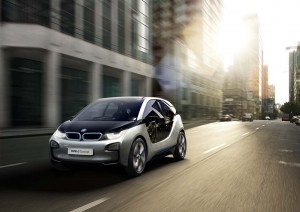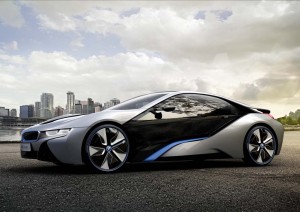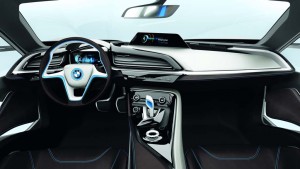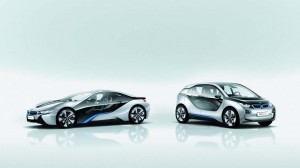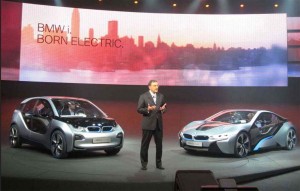
CEO Norbert Reithofer unveils the new BMW i3 and i9 battery cars - which will make a public debut at the Frankfurt Motor Show.
BMW has finally taken the wraps off two concept cars that signal the strategy of its long-anticipated electric car sub-brand, BMW i. The prototypes, which are set to make their formal public debut at the upcoming Frankfurt Motor Show, show the Bavarian maker positioning itself as the environmentally friendly leader in the competitive luxury car market.
During a Frankfurt news conference, BMW officials not only revealed both the BMW i3 and i8 concepts but also announced their investment in a new service called Parkatmyhouse. Using the Internet or a smartphone app, the service would permit homeowners and other individuals to rent out their parking spaces on a short or long-term basis.
Declaring the upcoming launch of the BMW i3 and BMW i8 a “milestone,” the German automaker’s Chairman Norbert Reithofer said the goal is to “offer customers purpose-built electric-drive cars,” rather than simply stuffing a battery-based drivetrain under the hood of a conventional automobile.
The potential advantage is that a dedicated battery-electric vehicle can be designed to minimize aerodynamic drag, reduce mass and improve weight balance to maximize performance and handling – critical attributes of the BMW brand.
The i3 is a so-called “city car,” meaning it is aimed at motorists in crowded urban areas that need a vehicle that is nimble as well as efficient. Originally dubbed the Megacity Vehicle, it will use lithium-ion battery technology to deliver just short of 100 miles range per change. Its electric motor driveline will produce 125 kilowatts, or roughly 170 horsepower, through the rear wheels. The maker expects 0 to 60 times of less than 8 seconds.
A high-speed charger, it noted, would yield an 80% battery charge in under one hour – though analysts anticipate it would be closer to four hours using a home 220-Volt system.
Despite its diminutive size, the vehicle will fit four with a reasonably large, 200-liter trunk capacity, the maker noted. Weight will come in at a light 2,750 pounds thanks to the use of what BMW describes as its new LifeDrive architecture, based on the use of advanced composites. Using a more conventional design and traditional materials, the maker explained, would add as much as 770 pounds.
“This vehicle will mark the launch of the first volume-produced car featuring bodywork largely made of carbon. It’s a revolution in automotive design,” explained BMW’s product development chief Klaus Draeger.
As for the bigger i8, it’s a plug-in hybrid electric vehicle, or PHEV, based on the wildly popular Vision EfficientDynamics show car that was one of the stars of the 2009 Frankfurt Motor Show.
Also designed to fit four, the BMW i8 Concept is more in line with the traditional BMW performance martra, it combination of gasoline and electric power capable of launching it from 0 to 60 in under 5 seconds – with a top speed of more than 150 mph — even though it is expected to use just three liters of gas per 100 kilometers, using the European system – or 78 miles per gallon in the U.S.
The plug-in hybrid drive would store enough energy in its lithium batteries to travel more than 20 miles in electric mode, but for longer journeys, or when higher performance is demanded, the 3.0-liter gas engine would fire up.
“The BMW i8 Concept is the sports car for a new generation – pure, emotional and sustainable,” Draeger suggested.
Like much of the auto industry, BMW has been exploring a wide range of sustainable options – a move particularly critical in the luxury market considering the conflicting demand for power and performance even as global fuel economy standards are ratcheted up.
Originally created in 2007 as Project i, the new brand-within-a-brand is being supported with a variety of investments totaling 530 million Euros. Among other things, the Munich-based maker is putting money into efforts that could transform carbon fiber from a high-cost, low-volume material to something with broader applications in the automotive mainstream. Meanwhile, BMW has also partnered with Samsung SDI and Robert Bosche GmbH on the development of the new brand’s battery technology.
While BMW i emphasizes battery-based mobility, it also is developing advanced connectivity systems that can help an owner with advanced route planning and – with the investment in Parkatmyhouse – even help a motorist find a parking spot where they might not be available on a regular basis.
BMW intends to offer the two new battery cars through its retail network around the world but will also rent the i3 and i8 through Europe’s Sixt rent-a-car firm.
The two models will be produced at the maker’s assembly plant in Leipzig, where several other urban models, such as the 1-Series and X1, are currently built. Production is set to start in 2013.

